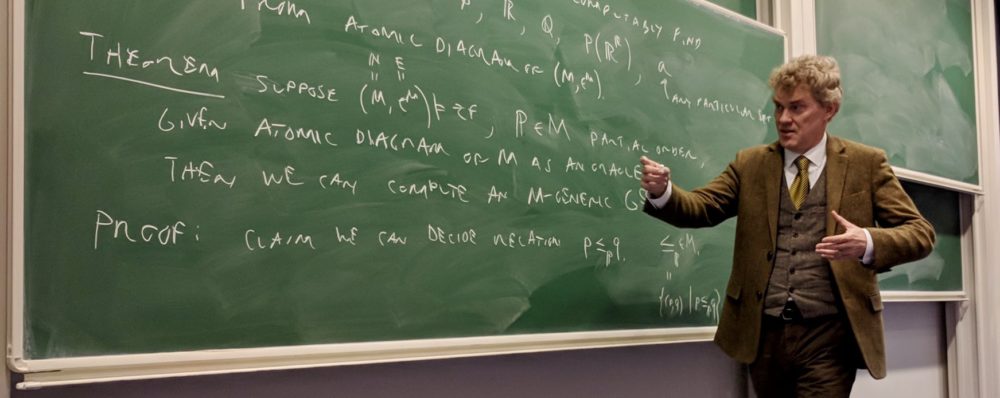[bibtex key=Hamkins1998:BookReviewMoschovakis]
Yiannis N. Moschovakis. Notes on Set Theory. This is a sophisticated undergraduate set theory text, packed with elegant proofs, historical explanations, and enlightening exercises, all presented at just the right level for a first course in set theory. Moschovakis focuses strongly on the Zermelo axioms, and shows clearly that much if not all of classical mathematics needs nothing more. Indeed, he says, “all the objects studied in classical algebra, analysis, functional analysis, topology, probability, differential equations, etc. can be found in [the least Zermelo universe] $\cal Z$” (p. 179). The analysis of this universe $\cal Z$ and the other set-theoretic universes like it at the book’s conclusion has the metamathematical flavor of the forcing arguments one might find in a more advanced text, and ultimately spurs one deeper into set theory.
The Notes begin, pre-axiomatically, with functions and equinumerosity, proving, for example, the uncountability of $\mathbb{R}$ and the Schröder-Bernstein Theorem. In a dramatic fashion, Moschovakis then slides smoothly into the General Comprehension Principle, citing its strong intuitive appeal, and then BOOM! the Russell paradox appears. With it, the need for an axiomatic approach is made plain. Introducing the basic Zermelo axioms of Extensionality, Empty-set, Pairing, Separation, Power set, Union, and a version of Infinity (but not yet the axioms of Choice, Foundation, or Replacement), he proceeds to found the familiar set theory on them.
Following a philosophy of faithful representation, Moschovakis holds, for example, that while functions may not actually be sets of ordered pairs, mathematics can be developed as if they were. A lively historical approach, including periodic quotations from Cantor, brings out one’s natural curiosity, and leads to the Cardinal Assignent Problem, the problem of finding a sensible meaning for the cardinality $|A|$ of any set $A$. Among the excellent exercises are several concerning Dedekind-finite sets.
After an axiomatic treatment of the natural numbers, with special attention paid to the Recursion Theorem (three different forms) and the cardinal arithmetic of the continuum (but no definition yet of $|A|$), Moschovakis emphasizes fixed point theorems, proving stronger and better recursion theorems. Wellorderings are treated in chapter seven, with transfinite arithmetic and recursion, but, lacking the Replacement axiom, without ordinals. After this the axiom of Choice arrives with its equivalents and consequences, but without a solution to the cardinal assignment problem. Chapter ten, on Baire space, is an excellent introduction to descriptive set theory. The axiom of Replacement finally appears in chapter eleven and is used to analyze the least Zermelo set-theoretic universe. Replacement leads naturally in the very last chapter to the familiar von Neumann ordinals, defined as the image of a wellorder under a von Neumann surjection (like a Mostowski collapse), and with them come the $\aleph_\alpha$, $\beth_\alpha$ and $V_\alpha$ hierarchies. Two well-written appendices, one, a careful construction of $\mathbb{R}$, the other, a brief flight into the meta-mathematical territory of models of set theory and the anti-foundation axiom, conclude the book.
The text is engaging, lively, and sophisticated; yet, I would like to point out some minor matters and make one serious criticism. The minor errors which mar the text include a mis-statement of the Generalized Continuum Hypothesis, making it trivially true, and an incorrect definition of continuity in 6.22, making some of the subsequent theorems false. Since there are also some editing failures and typographical errors, an errata sheet would be worthwhile. Moreover, the index could be improved; I could find, for example, no reference for $N^*$ and the entry for Cantor Set refers to only one of the two independent definitions. It is also curious that when proving the uncountability of $\mathbb{R}$, Moschovakis does not give the proof that many would find to be the easiest for undergraduates to grasp: direct diagonalization against decimal expansions. Rather, he diagonalizes to deduce the uncountability of $2^{\mathbb{N}}$ and then launches into a construction of the Cantor set, obtained by omitting middle thirds; then, appealing to the the completeness property, he injects $2^{\mathbb{N}}$ into it and finishes the argument.
My one serious objection to the text is that while Moschovakis shows impressively that much mathematics can be done with the relatively weak Zermelo axioms, his decision to postpone the Replacement axiom until the end of the book has the consequence that students are deprived of ordinals exactly when ordinals would help them the most: when using well-orders, cardinal arithmetic, and tranfinite recursion. Without ordinals transfinite recursion is encumbered with the notation, such as $\mathop{\rm seg}_{\langle U,\leq_U\rangle}(x)$, which arises when one must carry an arbitrary well-order $\langle U,\leq_U\rangle$ through every proof. And he is forced to be satisfied with weak solutions to the cardinal assignment problem, in which $|A|=_{\rm def}A$ is, tacitly, the best option. Additionally, the late arrival of Replacement also makes students unduly suspicious of it.
In summary, Moschovakis’ view that all of classical mathematics takes place in $\cal Z$ should be tempered by his observation (p. 239) that neither HF nor indeed even $\omega$ exist in $\cal Z$. In this sense, $\cal Z$ is a small town. And so while he says “one can live without knowing the ordinals, but not as well” (p. 189), I wish that they had come much earlier in the book. Otherwise, the book is a gem, densely packed with fantastic problems and clear, elegant proofs.
